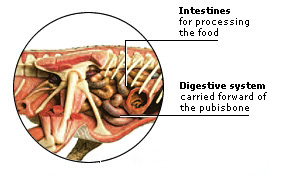DK Science: Digestive Systems
Carnivorous and herbivorous dinosaurs are quite easy to tell apart. As well as the different types of jaws and teeth, their body shapes were distinct from one another because of the different digestive systems they needed to absorb their food. Carnivores had much simpler digestive systems than herbivores, and their hip bones were arranged differently. These two characteristics meant that the carnivorous theropods were two-legged, the herbivorous sauropods were four-legged, and the herbivorous ornithopods could move around on either their hind legs or on all fours.
The tooth of a carnivorous dinosaur such as Tyrannosaurus is shaped like a steak knife. It is narrow like a blade, for slicing through flesh. It is also pointed for making incisions in its prey. Its edges had dozens of little serrations, like a fine saw, to tear through tough meat and tendons. Carnivore teeth quickly wore out and were easily damaged, breaking off if the dinosaur chomped on bone. Inside a carnivore’s jaw, other teeth were constantly growing and replacing those teeth that were lost.
A carnivore’s skull, like this one of an Allosaurus, was arranged so that it could work backwards and forwards. This movement allowed the rows of teeth to shear past each other, tearing the flesh of its prey between them. The teeth were curved back like barbs, so that anything held in its jaws would not stuggle out. The lightweight latticework of the skull and jaws meant that the sides of the mouth were able to move outwards. This widened the mouth so that the carnivore could swallow huge mouthfuls.
There are very few fossils that actually show the insides of a dinosaur. However, the digestive system of a carnivore would have been quite simple and fairly small compared with the size of the animal. Meat does not have tough fibres, so it is easily digested, and a carnivorous dinosaur did not need the huge guts of a herbivore to process its food. Nearly all of the carnivore’s digestive system would have been carried in front of the pubis bone of the lizard-like hips. This compact arrangement would have allowed the dinosaur to move swiftly when chasing its prey.
The different types of herbivore had different types of teeth, all of them unlike those of the carnivores. Some teeth, such as those of Iguanodon, were coarsely serrated like a vegetable grater for shredding plant material. These were slightly twisted and overlapping, and all tended to be the same size, unlike the jagged rows belonging to the carnivores. Other herbivores, especially the sauropods such as Diplodocus, had teeth that were arranged like the teeth of a garden rake. They used these for food-gathering, not for chewing.
Sauropods spent all their time raking the leaves from trees and plants and swallowing them. They did not chew because their teeth were the wrong shape. So, to break down their food, the herbivores swallowed stones. These gathered in an area of the stomach called the gizzard, forming a grinding mill to mash up the plant material. Skeletons of sauropods are sometimes found with polished stones, or gastroliths. Today’s plant-eating birds, such as chickens, swallow grit for the same reason.
The digestive system of a two-footed ornithopod was much bigger than that of a carnivore – more like a sauropod’s. However, unlike in a sauropod, it was carried well back in the body and the pubis bone was swept back out of the way. This meant the centre of gravity of the animal was much nearer the hips and it could move about on its hind legs. It also lacked a gizzard. With its efficient chewing system, an ornithopod did not need stomach stones.
The digestive system of a sauropod such as this Brachiosaurus was much bigger than that of the carnivores. It needed a large gut to break down the fibres in the plant material it ate. A sauropod would also have had a gizzard, where stomach stones ground up the food before it was passed into the stomach. All this weight had to be carried in front of the pubis bone, and that is why most sauropods could not support themselves for long on just their back legs.
To order this book direct from the publisher, visit DK's website.




